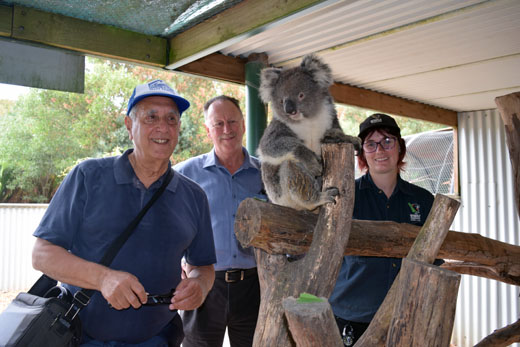
Editor’s Note: This is the eighth in a series of stories researched during Don and Nancy Harrison’s 50th Wedding Anniversary cruise from Sydney, Australia, to San Diego. Previous installments of the series, which runs every Thursday, may be found by tapping the number of the installment: 1, 2, 3, 4, 5, 6, 7
By Donald H. Harrison

BURNIE, Tasmania, Australia –Cruise ship passengers who visit this city in the northwestern portion of Tasmania receive a warm welcome in this city of 20,000 persons. Typically, the passengers visit from about 8 a.m. to 4:30 p.m., then continue on their way, either north across the Bass Strait to Australia, or east across the Tasman Sea to New Zealand.
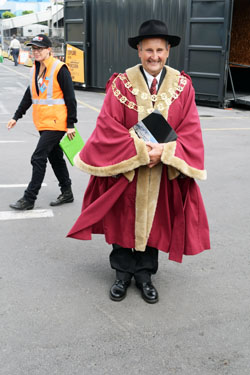
We were impressed from the moment we disembarked from our Holland America cruise ship, MS Maasdam, and found Mayor Alwyn Boyd, in his ceremonial robe of office, personally greeting our fellow passengers on the pier before they boarded complimentary shuttle buses to the Makers Workshop, which serves as an information center, point of embarkation for tours, and a showcase for paper maché sculptures that invoke Burnie’s past as a major producer of paper stock.
From their cruise ships, passengers fan out through Burnie and other parts of Tasmania, buying souvenirs, sampling local foods, taking tours, and helping to green the economy.
“Burnie has a big history with paper,” Nancy and I were told by Ian Jones, a vice president of the Burnie Chamber of Commerce and Industry, who hosted us on our visit. “Our major employer was a 4,500-employee paper-making facility that started in the 1930s and shut down in 2005,” he said, adding that the city has bounced back somewhat by exporting timber and heavy machinery for use inside tunnels.
David Happe, who lectures on ports-of-call aboard the Maasdam, alerted us that a company called Creative Paper continues to ply the paper-maker’s art on a cottage industry basis, mixing fibers with various other substances—including “roo poo,” that is, kangaroo manure – to create different textures and effects. “What is great about them is that they have a variety of processes to remove the bacteria,” said Happe. “You can go on paper-making tours at the workshop, learn about fibers, how they are obtained, and you can try your hand at making paper.”
One finds at the Makers Workshop life-sized paper maché sculptures, depicting life in Burnie. One of my favorites was of two men playing checkers, while their dog lies contentedly nearby. Another is of a bass player and a singer belting out a melody for concert goers.
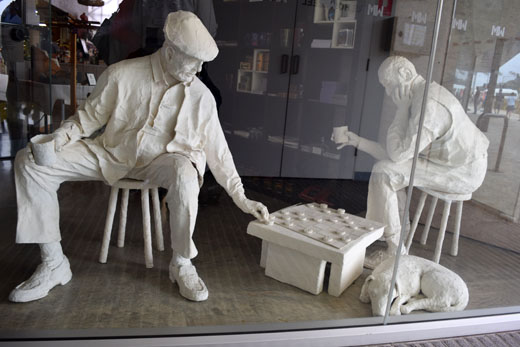
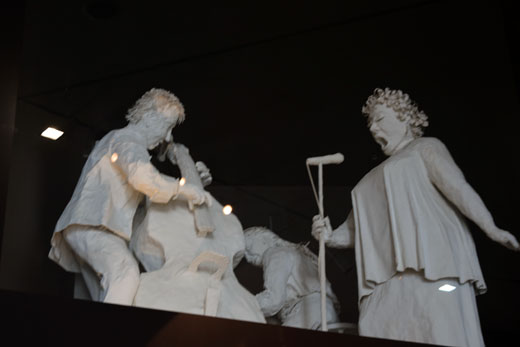
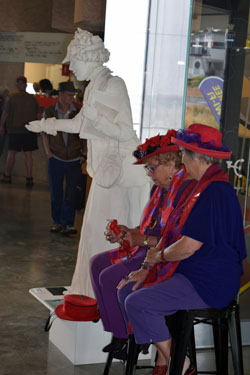 The warm welcome given to cruise ship passengers by the mayor, the Chamber of Commerce, and a fleet of volunteers, including women of the Red Hat Society (who typically wear purple clothes and red hats) is part natural graciousness and part salesmanship. Accompanying those smiles often is the hope that some cruise ship passengers of retirement age might consider settling in Burnie.
The warm welcome given to cruise ship passengers by the mayor, the Chamber of Commerce, and a fleet of volunteers, including women of the Red Hat Society (who typically wear purple clothes and red hats) is part natural graciousness and part salesmanship. Accompanying those smiles often is the hope that some cruise ship passengers of retirement age might consider settling in Burnie.
Jones explains, “If we had cashed-up retirees here, they would be spending money in the local economy of the community. They would buy their groceries and clothing, and put money into the local economy. We need jobs. We want to keep our young people here.”
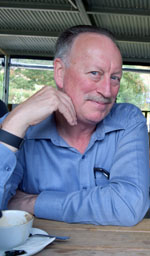
Among Tasmania’s young people, he added, there is a “brain drain” to the Australian mainland where they can find jobs and greater prospects for a career. Jones said even his own daughter left Burnie for Melbourne, where she is embarked upon a career in the hotel industry.
Greater population can mean more money in the economy, leading to more jobs and greater diversification. It’s a win-win scenario, Jones told us. While an influx of retirees will help Burnie; there’s plenty in this small city that will be appealing to the retirees.
“Burnie is a great place,” Jones said. “It is cheap to live here. We have some of the world’s best meat, some of the world’s best vegetables, and getting around is so easy. A friend of mine is interviewing for his restaurant a chef who now lives in Melbourne. She wants to come here, where she will be able to walk from home to work, and won’t need a car, for which she now spends $50 a week on petrol. She will be able to pay $170 a month for a single or two-bedroom apartment, whereas my daughter in Melbourne is paying $400 for a two-bedroom apartment.”

Besides the lower cost of living, said Jones, another attraction of Burnie is the “reasonably active theatre scene down here. The local council runs an arts program, and they always have something going on. Currently they have some comedians coming through. Devenport is a half-hour drive from here, and they also have an active cultural center.”
Further, said Jones enthusiastically, “we have the cleanest air in the world here, and we make the best beer. We have Boags here, and another is Cascade from the south of Tasmania. Ghost Rock makes beautiful wines here as well – pinot noirs mainly. The climate is just right for pinot noirs and sauvignon blancs.”
There also is a whiskey distillery, Hellyer’s Road, which makes single malt products, he said.
Aboard the Maasdam, Happe had told us that Burnie offers visitors a regional museum that includes within its walls a historic street of a pioneer village. Next door, he said, is a regional art gallery, which focuses on Australian art, and just outside town is a rhododendron garden, with walkways and waterways where you just might find a platypus, one of Australia’s exotic species of animals. Also close to town is a fern glade reserve, good for nature walks. Along the coast, one might find blue penguins, the smallest members of the penguin family. A longer bus ride, about 90-minutes each way, takes visitors to Cradle Mountain, which offers panoramic views and up-close opportunities to study the effects of glaciation.
Nancy and I chose to visit another attraction Happe had highlighted, Wing’s Wildlife Park, located in the nearby village of Gunns Plains, where the owner, Colin Wing, has chosen to focus on the native species of Australia, among them Tasmanian Devils, the koala, wallabies, kangaroos, wombats, dingoes, and quolls. Here, under supervision, one can hold or pet such animals—and Nancy and I thereby became friends with a koala, some kangaroos and their little joeys, and even some Tasmanian Devils which were too young to be nasty.
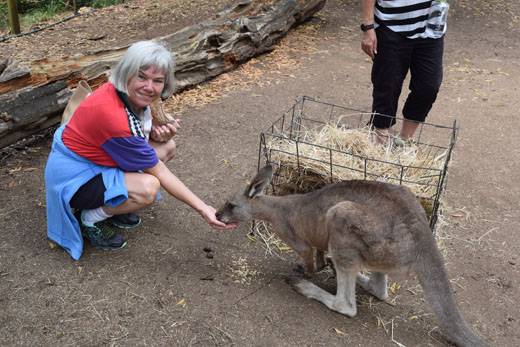
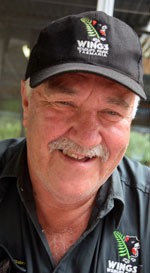
Wing told us that his family had been dairy farmers for eight generations, and in more recent years had been diversifying, raising some crops while switching the bulk of its herds from dairy to meat production. Along the way, the Wing family opened a large campground for people to put up their tents, or rent a small cabin, and to go hiking and exploring through the Tasmanian outback. From there, the family branched into the restaurant and private zoo business, both of which provide employment for local residents as well as for family members. On cruise ship days, when local residents see tour buses head for the park, they put on their uniforms and report to work, Wing said. The restaurant, which features “paddock to plate” steaks, offers meat that had been butchered as few as two hours before it being cooked and served. He said the restaurant has attracted such a following that as many as 500 people a day will come to the restaurant and park, even without a cruise ship being in port.
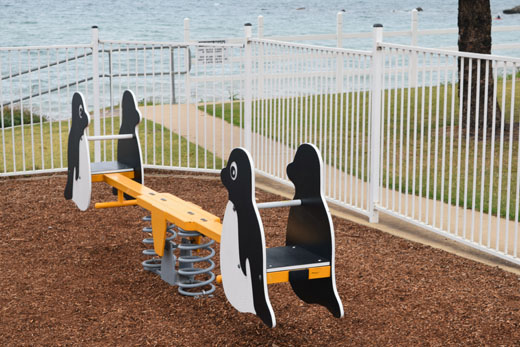
After visiting Wing’s Wildlife Preserve with us, our gracious host Ian Jones took us on a tour of other close by venues on the island, including the town of Penguin, which has a larger than life size Penguin statue adorning its main square, and a playground boasting penguin seats on its seesaws.
While there are a few hotels and B&B’s in Burnie and vicinity, he said, the area does not yet have the capacity to handle large contingents of overnight guests. That’s good and bad, one supposes. It’s bad because some large hotels would add to Burnie’s employment base, and perhaps bring home Jones’ daughter and other youth now living on the mainland. It’s good for visitors because Burnie’s unhurried, nice-to-meet-you ambiance—as it is today–is relaxing, pristine, and friendly.
*
Harrison is editor of San Diego Jewish World. He may be contacted via donald.harrison@sdjewishworld.com
Pingback: Cruise ship singer plans solo show on land | San Diego Jewish World